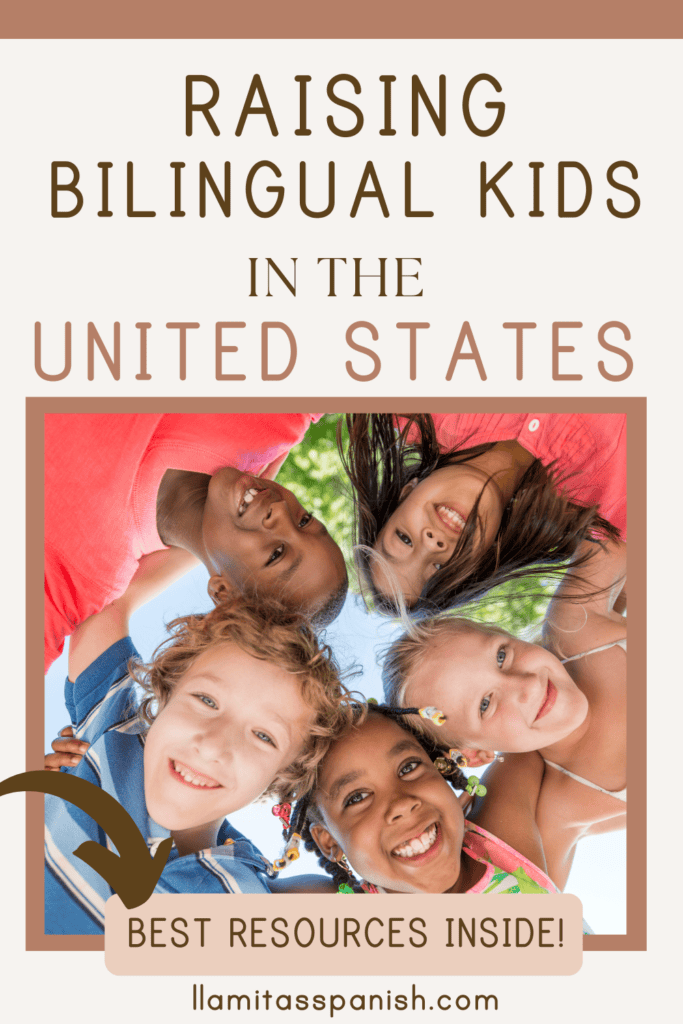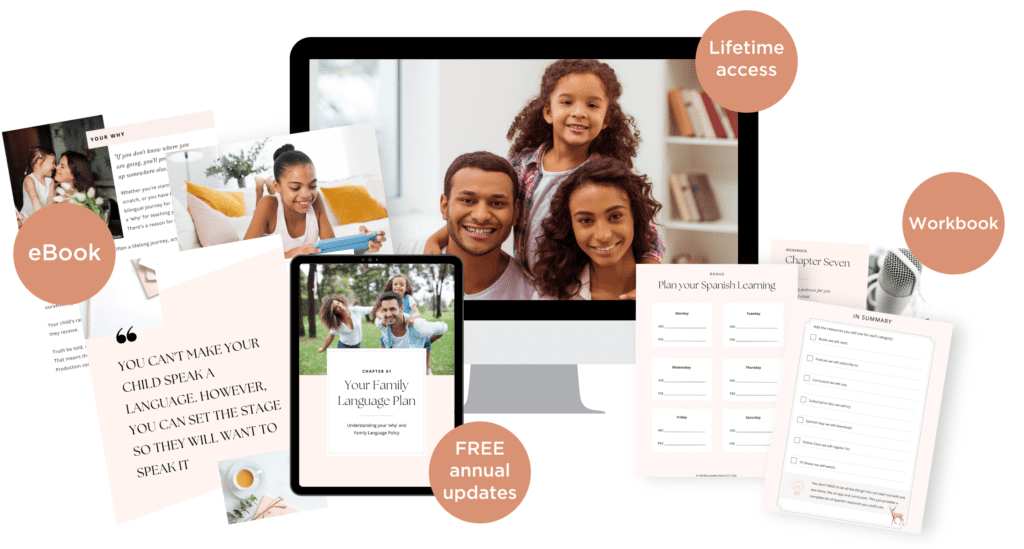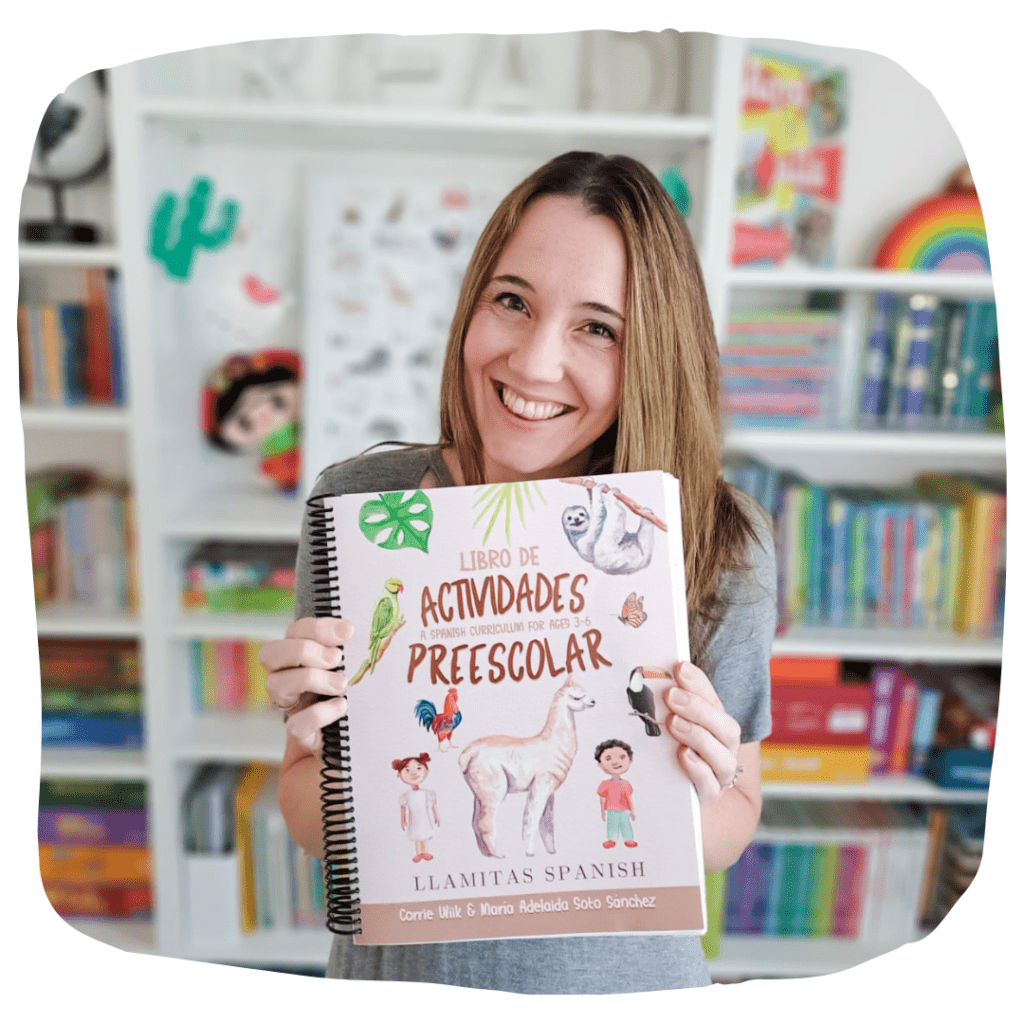In this post: The truth about raising bilingual kids in the USA and resources to support bilingual parents.

This post contains affiliate links. As an Amazon associate I earn from qualifying purchases.
Raising bilingual children, especially in the U.S., is both a challenging and enriching experience for the whole family.
While in many cases we, or our parents or grandparents, brought our language with us from our homeland, the reality is that passing down our native language to our children takes a pretty fair amount of effort. That’s because the best way to provide language immersion is by combining a variety of resources.
To help you round out your child’s Spanish education, download our Family Language Plan and Resource Guide for Spanish, which provides a deep dive into the variety of cultural resources you can use to enhance Spanish learning for your kids.
Table of Contents
Bilingualism in the USA
While most of the world is bilingual or multilingual, the U.S. population has largely been an exception to this rule. For many years, it was thought that speaking more than one language at home curtailed children’s ability to learn.
It wasn’t until the mid-1960s that studies were done and published which reported that bilingualism actually provides many benefits to the mind and brain.
Not only does bilingualism improve social skills, it also enhances mental activity and is even believed to delay the onset of cognitive diseases such as dementia.
Bilingualism began to gain a foothold in the U.S. after the Cuban Revolution took place in 1959, and thousands of Cubans fled their native country in search of a better life in the U.S.
The vast majority of these immigrants were upper middle-class professionals who were committed to simultaneously maintaining their language and culture while assimilating into their new English-speaking country.
Many Hispanic/Latino families are now firmly committed to raising bilingual children to enhance their children’s social and academic skills as well as to build confidence and take pride in their heritage and identity.
Currently, about 21.6% of people in the U.S. (or 1 in every 5 adults) speak language at home other than English, according to the U.S. Census Bureau. And bilingual speakers are growing by the minute as Hispanic/Latino families begin to take more pride in passing down the Spanish language to their children.
Common Challenges of Raising Bilingual Kids in the USA
Gone are the days when immigrant parents and grandparents tried to protect their children from discrimination by forcing them to speak only English at home. Today, most Latino and Hispanic families are proudly choosing to raise hijos bilingües.
But, while bilingualism is gaining popularity in the U.S., there are still challenges for families who want to raise bilingual children, such as:
- limited Spanish language resources in public spaces
- limited access to Spanish language books and songs
- kids who refuse to speak Spanish because they’re embarrassed
- challenges to bilingual education opportunities in public schools.
Luckily, many of these challenges are actually not so difficult to overcome. To learn more about the most common challenges to raising bilingual children and how to address them, check out our guest post written by our friend Rebeca Imberg on Challenges to Raising Bilingual Kids.
In addition to challenges posed by the monolingual leanings of U.S. culture, as well as the lack of solid resources for bilingual education in the U.S., there are legislative challenges as well.
For example, in California, Proposition 227 would require California public schools to teach Limited English Proficient (LEP) students in special classes taught almost entirely in English, essentially eliminating “bilingual” classes in many cases.
To offset this, Proposition 58 repeals Proposition 227’s English-only requirement, so students have the option of learning English via multiple programs beyond English immersion classes.
Bilingual Homeschooling in the US
One of the chief ways that many families are successfully raising bilingual kids is through bilingual homeschooling. This allows the parents to fully customize the child’s Spanish education experience, and to curate the educational materials that may be used in daily lessons.
For excellent tips by moms who are leading the way with bilingual education at home, check out our blog post about Bilingual Homeschooling Moms in the USA.
The best homeschool Spanish curriculums available are those that fully integrate Spanish education with extra-curricular activities to get your child to think and respond in Spanish and to understand Hispanic and Latino cultural traditions, far beyond class time.
To get started on teaching Spanish to your children at home, begin by enrolling in our fully-enriched Llamitas Spanish Curriculum.
With open & go bilingual scripts, our curriculum can be facilitated in Spanish or English, supporting both native and heritage Spanish speakers and beginners alike.
Family Language Plan
To give your family the best chance of success at raising fully bilingual children, it is recommended that you make a Family Language Plan (FLP). While ideally, this plan should begin at the child’s birth, it is never too late to begin working on an effective FLP.
The FLP basically is a plan that follows your child from birth (or whenever you start the plan) until the completion of high school or secondary school. The plan should include all of the resources you’ll use to give your child every opportunity to practice the new language as often as possible.
Creating a family language plan helps families examine their options, and plot a strategy to reach their learning goals step by step.
The FLP should include:
- Your learning goals
- Your language sources and resources
- Potential challenges and how to deal with them
One of the most important components of the FLP will be the primary curriculum that you choose to teach your child Spanish.
Our Llamitas Spanish Curriculum is packed with relevant thematic lessons, resources and tools to nurture a love of the Spanish language and Hispanic culture at home.
Resources to Support Bilingual Parents
You can enhance your child’s Spanish learning experience by adding access to other materials that encourage kids to practice the Spanish language while singing along, playing, or reading stories.
Here are some of our educational resources to help you round out your child’s curriculum with plenty of fun activities that help to bring the Spanish language to everyday life.
These are additional resources for parents to provide insights into the bilingual parenting and homeschooling experience.
Your child’s Spanish learning journey can be a fun and inspiring element in your family life. The more you choose to enjoy our many extra-curricular resources, the sooner you’ll hear your little ones happily speaking fluently ¡en español!




